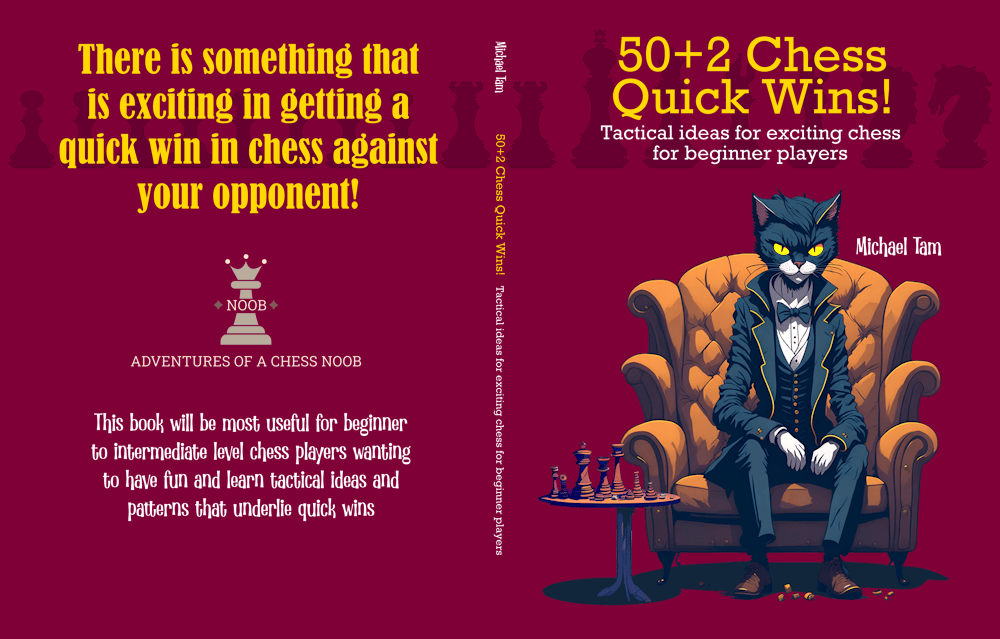
Vienna Gambit Declined 3... Nc6 | Another CHESS BIKER, I'm not alone! 🤩♟️🏍️
#twoknightstango #tunnelvision #viennagambit #brilliant #motorcyclechess
My regular subscribers will know that my favourite opening with White is the Vienna Game and where possible, I try to play the Vienna Gambit! It’s a tricky and very fun opening for White, that can seem unreasonably effective when you know how to play it! Evidence for this is the line that occurred in this game – the Vienna Gambit, Declined 3… Nc6. It’s one of the most common responses by Black, looks sensible, but disastrous!
![]()
A digression... motorcycles and chess!
But firstly, a little about my opponent, a very cool person from Austria! Recently, I made a new online chess acquaintance and friend, @minimagnus75 who I originally corresponded with on the Chessnut Backers Group on Facebook at around the time I received a review Chessnut GO board. They noted that they were quite interested in taking a portable board on their motorcycle, and posted a photo of their bike, the superlative Kawasaki Z650RS! I was very interested, as I was thinking about trading in my old commuter, a 2016 Yamaha MT03 for a new bike as it was starting to have some mechanical issues. I’d owned another Kawasaki “sport retro” bike in the past so was relatively familiar with the model. After discussing with them about their experiences, I pulled the plug and made the purchase at my local Kawasaki dealer. 😁

![]()
The 2024 Kawasaki Z650RS is a thoroughly modern motorcycle but takes its styling cues from its retro namesake from almost half a century ago. The original 1976 Kawasaki Z650 (or KZ650 in North America) has been described as the epitome of the UJMs (typified by a four-cylinder engine, each individually carburetted, telescopic front forks, front disc brake, and a standard riding position) of the 1970s.

![]()
Interestingly, the term UJM (universal Japanese motorcycle) was sometimes used derisively towards the Japanese inline fours in the 1970s, as the era and dominance of the iconic British twins came to an end. Nostalgia is a funny thing, however. For me, a “UJM” is what a motorcycle “looks like” in my mind’s eye, while a British twin (e.g., a Triumph Bonneville, which I’ve also previously owned) is an “old-looking” motorcycle.
I felt a degree of kinship with my mate @minimagnus75 – chess, electronic chess boards, the same model motorcycle, and with an interest in taking a chess board on travel! I don’t usually play daily games outside of tournaments anymore, but I made an exception!

![]()
Game 1: Black Knight’s Tango – I dance, trip, and faceplant…
Game 1: https://www.chess.com/game/daily/665293341
I’ll describe our first game only very briefly. I had the Black pieces and White led with the tricky Réti Opening, which I usually respond with the Black Mustang Defense (1. Nf3 Nc6). I don’t have a special approach to the Réti and am hoping to transpose back to a e4 e5 game. However, my mate then played d4 and then c4, which transposed the game into the delightfully named Indian Game: Black Knights’ Tango! 🤩
We were both long out of theory and I thought I played the opening an early middlegame, “okay”, and the game was mostly equal. However, on move 18, I got caught in tunnel vision and straight up blundered my rook (18… Rxb3?? 19. Qxb3). 🫠 It’s one of the reasons I don’t play daily too often now – I just lose my train of thought in between moves! I tried to create some threats, but it was all rather hopeless. White played extremely solidly and never lost the advantage. They opted to play defensively until their king was absolutely safe, and then launched an unstoppable incremental attack. Well done!
![]()
Game 2: Vienna Gambit - an Austrian lost in Vienna!
After the game ended, we chatted briefly and I invited my mate for a game of 15+10 rapid, to which they graciously obliged, even though they didn’t play rapid often. It was relatively late at night in Sydney, but I was hoping to get a win to equalise! 😅
I had the White pieces this time, and I played the (Falkbeer) Vienna Gambit, an opening to which @minimagnus57 was not familiar. They declined the gambit by developing their other knight (1. e4 e5 2. Nc3 Nf6 3. f4 Nc6?), an intuitive move that is nonetheless a mistake!
A historical note:
The Vienna Gambit is a very effective opening. According to the Lichess community database, White wins almost 60% of the time from the position, which is rather extraordinary on move 3 given that objectively Black has yet to make any mistakes! In fact, I would argue that in the modern environment of online chess and chess social media, with the popularisation of the Vienna Gambit, that the gambit is probably less effective as many people will be wary of some of the tricks and traps.
A case in point is the line of this game, Declining with 3… Nc6. This move is the third most common response (very close to second) by Black at the beginner-intermediate level, but it is a categorical mistake and White gains a major advantage according to the engine [+1.6], with a win ratio over Black of almost 2:1! If Black isn’t familiar with the Vienna Gambit, Nc6 appears to be a reasonable move and seems to fit with the opening principle of developing knights early.
Indeed, the first instance of this position is in a game (transposed from the Max Lange, Vienna Gambit) from the famous series of games played between future first world chess champion, Wilhelm Steinitz (1836-1900), and Henry Bird (1829-1908) held in London in 1866. Steinitz, born in the then Austrian Empire, and having spent several years in Vienna, was very familiar with the developing Hamppe’s Game (what would later be named the “Vienna Game”).

For Bird, an Englishman, the Vienna Gambit and Gambit would have been a novelty in the mid-19th century. Although Bird was not of the same calibre as Steinitz, he was nonetheless a strong player, and yet still played 3… Nc6. When we look at chess databases there are many historical games of strong and competitive players making this same mistake. As a heuristic, it’s usually at “fine” (if not “good”) to play the two knights in e4 e5 openings, making this very much a trap for the unwary!
Check out (Steinitz — Bird, 1866, London, UK) where Steinitz crushes Bird in 23 moves!
![]()
As we can see in the Steinitz—Bird game, White immediately punishes (3… Nc6) with (4. fxe5), as after (4… Nxe5), White then chases Black’s knights repeatedly with central pawn advances, winning tempo and eventually forcing Black’s king’s knight to un-develop (5. d4 Nc6 6. e5! Ng8).
In this game, we get an almost prototypical Vienna Gambit game: White develops their pieces, castles kingside, and then uses their advantage in development and the semi-open f-file to launch a crushing attack on Black’s f7-square. The move (10. Bxf7+!!), ostensibly sacrificing the bishop by capturing Black’s f-pawn with check, fully opening the f-file, is a very thematic tactic. If Black’s king captures the bishop, White’s knight leaps forward into the attack (Ng5+) with a powerful double-check!
Impressively, Black spent the time calculating this through and found the most accurate response (10… Kd7). I’d never actually had an opponent who found this previously, so had to calculate the next move myself! 🤔 I agonised for about two minutes over three candidate moves (h3, d5, and Nd5), and wasn’t sure which was the best. I eventually played (11. h3), which worked, and discovered on analysis that all three moves were good! 😅
White responded to the pressure by trading their bishop for my knight (11… Bxf3 12. Qxf3), which brought my queen into a battery with the rook down the f-file. In the very difficult position, Black attempted to develop (12… Nge7??), but this was a mistake. Black had one last chance to avoid checkmate and this crowding of the position doomed the king [+M4]. After (13. Qg4+), my mate saw that all hope was lost. The line is quite lovely as on each turn, Black has only a single forced move available – (13… Nf5 14. Qxf5+ Ke7 15. Qe6+ Kf8 16. Be8+ Qf6 17. Rxf6+ gxf6 18. Qf7#). Good game, GG!
The big takeaway from this game is to consider trying the Vienna Game and Vienna Gambit if you’re keen on exciting chess!



